Nature trail
Insect world:
Moths - beauties in their own right
The variety of animals that share our hom - planet Earth with us is
countless. Thanks to the tireless efforts of many a scientist and
environmental researcher, we are aware of most of these animals which
have been categorised into many groups such as mammals, reptiles,
amphibians, insects and so on. Did you know that insects belong to the
biggest group of animals on Earth?
They are found almost everywhere; on mountain tops, deserts, forests,
meadows and in freshwater. The only place they have not colonised is the
sea!
Today, we introduce you to some members of the moth family, one of
the species that belongs to this largest group of animals, the insects.
Insects are varied in appearance, but they all share the same
characteristics; the body is divided into there main parts which
comprise the head, thorax and the abdomen. The insect we feature today
is the moth.
Moths too belong to the order Lepidoptera like the butterflies, but
most of them are not as fragile and beautiful as the butterflies. Most
moths are nocturnal, but there are crespular and diurnal moths too.
Even though moths and butterflies seem similar in appearance, there
are many features that separate the two species. In general, their
feelers or antennae are different. For instance, butterflies have thin,
slender filamentous antennae that are club-shaped at the end. Moths have
comb-like or feathery antennae and no club shape at the end.
However, there are exceptions to the rule, with a few species of
butterflies lacking the club shaped antennae and certain species of
moths having such antennae.
Then there is a difference when it comes to the cocoons the
caterpillars build. Most moth caterpillars build cocoons out of silk in
which they metamorphose into the pupal stage. They are usually dark
coloured and thick. But butterflies have exposed pupa that are
glistening or see-through.
They are also known as chrysalis. Moths have hairy, stout and funny
looking bodies while butterflies have slender, smoother abdomens. The
scales on the wings of a moth are also different to those on butterflies
making them look fluffy and dense. Butterflies have fine scales.
Most moths usually rest with their wings spread wide, but butterflies
have their wings close together when resting, except when they are
basking in the sun.
As we explained earlier, moths are not as colourful as butterflies;
most nocturnal moths are plain brown, grey, white or black with obscure
patterns such as zig-zags or swirls for camouflage.
But, certain moths, mostly the day ones, are somewhat colourful,
especially if they are toxic.
Moths come in all shapes and sizes and all are very different from
their caterpillars. Let’s check out the features of a few of these moths
in detail...
Giant peacock moth (Saturnia pyri)
 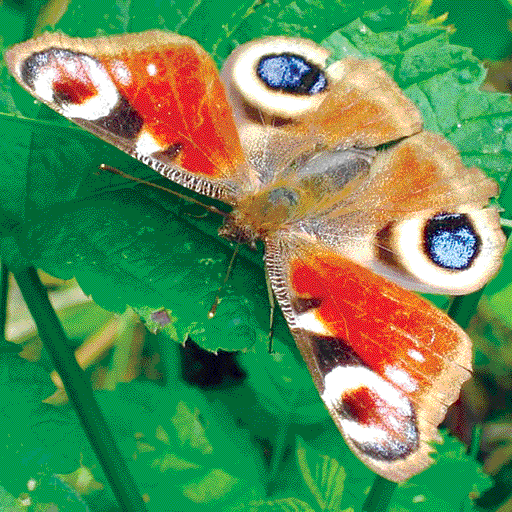 The largest European moth, it is also called the Great peacock moth,
Giant European moth or the Vienes moth. Its range includes the Iberian
Peninsula, Southern France, Italy, and extending into Siberia and North
Africa. The largest European moth, it is also called the Great peacock moth,
Giant European moth or the Vienes moth. Its range includes the Iberian
Peninsula, Southern France, Italy, and extending into Siberia and North
Africa.
Its smaller relatives are the Emperor moths. These moths which are
largely nocturnal are so large, with a wingspan of about 15cm (6
inches), that they could easily be mistaken for small bats when flying
in the night.
They are greyish brown or mottled-brown in colour with an oval-like
eye marking on each wing.
The wings are edged with white and yellow. Females are somewhat
larger than the males.
The larve start off as black with red or orange rings. When fully
grown, reaching 9-10 cm, they turn green with raised sky-blue tubercles
which bear crowns of sharp, liquid-filled spines and long hairs. The
caterpillars feed mostly on fruit trees. The adult moths frequent
orchards. The moths prefer open country side.It is considered to be one
of the rarest moths in Europe.
Garden tiger moth (Arctia caja)
A moth of the Arctidae family it has a wingspan of 45-65mm and
varying wing designs. While its front wings are brown in colour with a
white design (which can be missing in some), its back or hindwings are
orange or reddish coloured with patterns containing black dots. It is
one of the more coloured moths, as it’s toxic.
 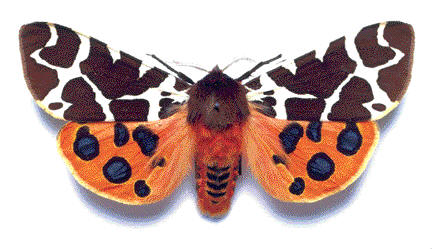 The conspicuous patterns on the wings serve as a warning to predators
as its body fluids are poisonous. Normally, the moth hides its hindwings
under the cryptic forewings when resting as a measure of camouflage and
exposes the reddish coloured hindwings only when threatened, before
flying away for safety. The conspicuous patterns on the wings serve as a warning to predators
as its body fluids are poisonous. Normally, the moth hides its hindwings
under the cryptic forewings when resting as a measure of camouflage and
exposes the reddish coloured hindwings only when threatened, before
flying away for safety.
The Garden tiger moth is found throughout Europe, as far as Lapland,
in Asia and in North America.
It’s usually found at elevations of 2,000 metres (6,600ft) in damp
places. It’s also common in gardens, parks and river valleys.
This distinctive coloured moth’s caterpillar is seen frequently
feeding on non-woody plants as well as bushes and trees. It’s fond of
raspberries, blackberries and erica.
The larva grows to a length of 6cm (2 1/2 in) and becomes a
long-haired caterpillar.
It hatches during August from a large, bluish-white clutch of eggs
laid on the surfaces of leaves by the Mama Moth, in about July.
The caterpillars pupate during June/July the following year. The
caterpillars play ‘dead’ when threatened.The larvae of this stout, hairy
moth causes rashes and skin irritation when touched.
Indian moon moth (Actias selene)
  An attractive moth, with a wingspan of 80-100 mm (3.1-3.9 in), it is
found in forests of India, China, Malaysia, Indonesia and our own
country. An attractive moth, with a wingspan of 80-100 mm (3.1-3.9 in), it is
found in forests of India, China, Malaysia, Indonesia and our own
country.
It is one of the moth species which has an acute sense of smell. The
male Indian moon moth has large antennae which are clearly ‘feathery’.
On each side of the antennae are large graduated branches covered with
long hairs. This greatly increases the surface area over which chemical
ordours can be detected by minute and sensitive detectors.
In fact, it is believed that the male can detect the scent of a
female moth which is as far as 5 km (3 miles) away! Its sense of smell
and the ability to follow this scent while winding its way through
woodland, ignoring obstacles and other scents, is so advanced that some
experts say that the bloodhound (a breed of dog with a strong sense of
smell) can be called an amateur when compared to the male Indian moon
moth.
The caterpillars feed on various shrubs such as prunus, malus and
pyrus.
Death’s head hawk moth (Acheronita atropos )
 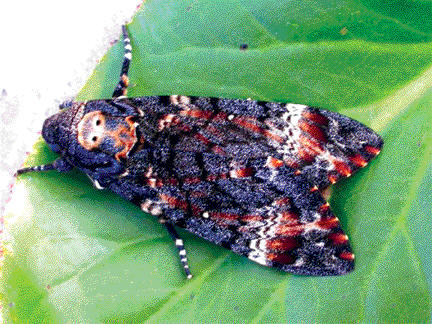 Distributed over Europe, Asia and Africa, it is a large hawk moth
with a powerful flight. In fact, it is labelled by some as the world’s
fastest-flying insect. Many insects are normally known to burst into
certain high speeds of flight when threatened, but this particular
species is credited with speeds of nearly 54 km/h (34 mph). Hard to
believe? It’s true. Distributed over Europe, Asia and Africa, it is a large hawk moth
with a powerful flight. In fact, it is labelled by some as the world’s
fastest-flying insect. Many insects are normally known to burst into
certain high speeds of flight when threatened, but this particular
species is credited with speeds of nearly 54 km/h (34 mph). Hard to
believe? It’s true.
It is a migrant to northern Europe, including Britain. Its common
name comes from the skull-like pattern on the top of its thorax. It has
the ability to expel air from its body sharply, producing a mouse-like
squeak. This, combined with its skull motif on the thorax has led many
to believe that this moth is harmful.
The larvae feed on potatoes, tea-trees and other
solanaceous(belonging to the potato ang nightshade genus) plants.
However, the adult moth, flies at night during warmer weather, feeding,
not on nectar, like many other species of hawk moths, but on the sap of
trees and on honey in bee’s nests.
Recent studies on the aerodynamics of this moth’s flight have shown
that it is not a simple up-and-down beat of the wings, but a much more
complicated process.
It’s said to involve four different wing movements too rapid for us
to see with our naked eyes. It could be seen only with a high speed
camera.
Magpie moth (Abraxas grossulariata)
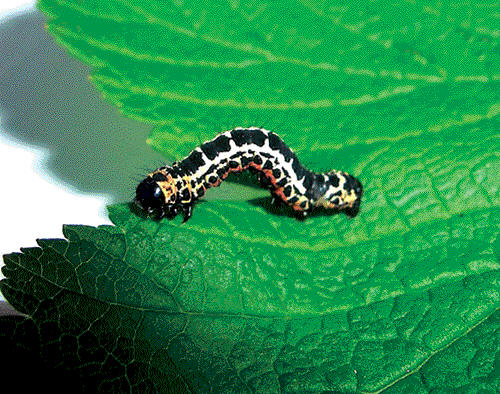 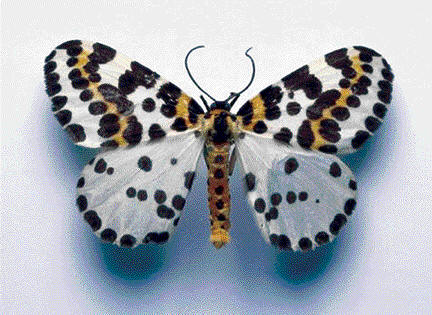 Native to New Zealand, it is a medium sized moth with a wingspan of
35-45 mm,. A similar moth is also found in parts of Australia. It is now
widespread and is common in Britain too. It’s found in a wide variety of
habitats, particularly woodlands, coastal, dunes, grasslands and
gardens. Native to New Zealand, it is a medium sized moth with a wingspan of
35-45 mm,. A similar moth is also found in parts of Australia. It is now
widespread and is common in Britain too. It’s found in a wide variety of
habitats, particularly woodlands, coastal, dunes, grasslands and
gardens.
The moth’s ‘wooly bear’ caterpillars are predominantly black with
yellowish - orange and white stripes running along the length of their
bodies.
They also have long black bristles. The colourful hairy larvae could
be seen openly feeding on plants, often stripping off all the leaves.
The adult moths can be seen feeding on flowers, especially plants of the
daisy family.They are very destructive.
It’s a highly variable species, prone to much individual colour
variations.
In some, the wings are predominantly white marked with heavy black
spotting and some its black(or brownish) with white patches.
There is a pale orange crossline running across the forewing near the
outer margin. The hindwing is whiter with a row of black spots on the
outer margin.
Males and females look similar. The Magpie moth seems to have
immunity to spider venom. |
